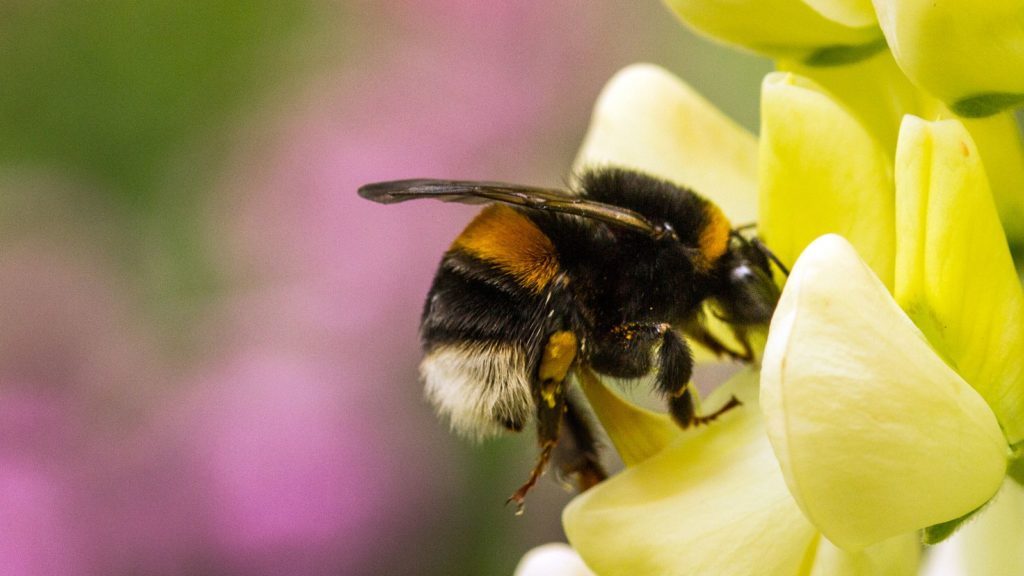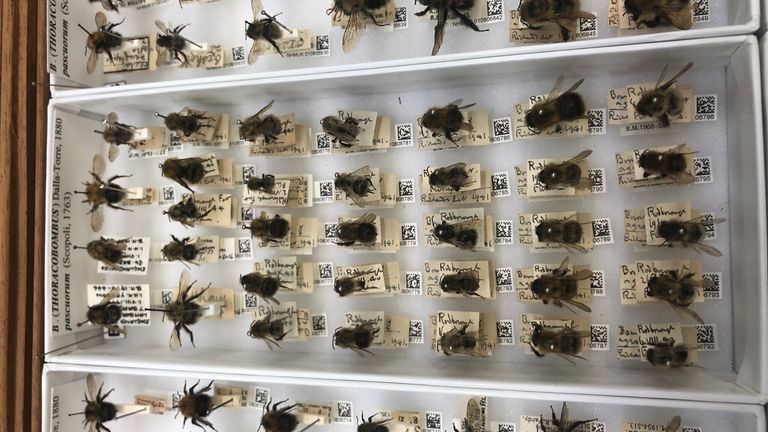This summer’s heatwave could have been bad for British bumblebees | Science & Tech News

This summer’s heatwave could have been bad for British bumblebees, according to new analysis that studied long-dead collections of bees held in museums.
Bumblebees have endured nearly a century of stress, possibly due to hotter, wetter conditions the research shows, but new DNA techniques may help focus future conservation efforts.
Researchers from Imperial College London and the Natural History Museum teamed up with four other Scottish and English museums to analyse their bumblebee collections to look for variations in body shape.
When bumblebees are stressed, it has an impact on their developing offspring. Their bodies – wings in particular – become asymmetrical. By correlating the level of asymmetry in four species of bumblebee to climate records over the last 120 years, the researchers discovered stress appears linked to climatic conditions.
“When conditions were warm and relatively wet, stress was higher,” says Dr Richard Gill of Imperial College London, who led the study.
Pic: Ashleigh Whiffin
Climate change was already known to be having an impact on the geographical distribution of some bumblebees, but this is the first study to show its potential impacts on insects living in the past.
“Museum specimens are almost like little time machines tracking that stress,” says Dr Gill.
The researchers found that for the species they studied, stress levels were lowest around 1925. Since then, there’s been a general increase in stress levels – with higher levels found in years that were both wetter and warmer than average.
Why things started to change around 1925 isn’t clear, according to the research team. One possibility, is that it’s linked to changes in agricultural practices and the use of pesticides which are known to have led to insect declines in the later part of the 20th Century.
That is pure speculation, stresses Dr Gill. However, a parallel study also published today could help pinpoint threats to bumblebees and wider insect declines by extracting DNA from museum specimens.
Borrowing techniques used to study ancient DNA from the likes of Neanderthal man and woolly mammoths, Professor Ian Barnes of the Natural History Museum was able to salvage genetic data from dry, dusty bumblebees collections.
Taking just a single leg from around 100 bee specimens his team was able to reconstruct genomes from long-dead bees – a hugely valuable tool when compared to the genetic code of bees living today.
“One genome constitutes such a vast amount of information about a past situation,” says Prof Barnes.

Pic: Richard Gill
By matching historical data on things like climate, pesticide use and changes in land use with the genetics of bees at the time, the researchers can see how the bee populations responded, or identify whether particular species were more vulnerable to changes than others.
“We can look for changes in diversity or signals of adaptation,” says Dr Gill. “It might reveal things we can’t see on the outside of a bee”.
Getting a picture of how bees coped with stresses in the past, could help focus conservation efforts in future according to the researchers.
The work also highlights how important museums are for forward-looking research.
“These museums have got all the secrets, it’s just about unlocking them,” says Dr Gill.
Recent Posts
- Fred Olsen Cruise Lines ship makes Newcastle debut
- Agent Diary: Wildlife experiences are a big draw – be sure to sell only the ethical ones
- Virgin Atlantic plans electric air taxi service for UK
- Algarve ranks as cheapest destination in holiday money barometer
- Why you need to visit the Boyne Valley on your next Ireland trip







Recent Comments